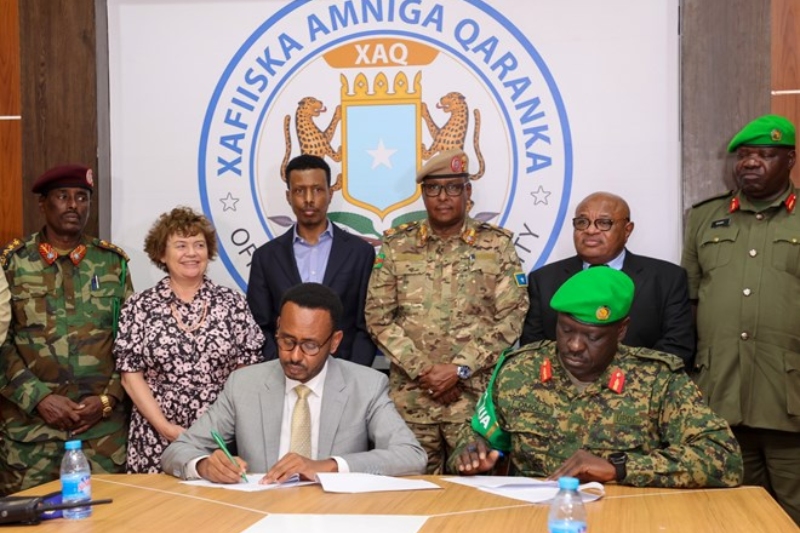State House and Legislative Building Handover
The State House, also referred to as Villa Somalia, serves as the residence and workplace of Somali President Mohammed Hassan Sheikh Mohamud. ATMIS has now transferred security responsibilities for this establishment to Somali government forces. Additionally, the mission handed over security duties for the legislative building, situated in close proximity to the presidential palace, to the army.
Since 2007, African Union soldiers have collaborated with Somali forces to secure pivotal locations in the capital city, including the palace, parliament building, airport, and harbor. Presently, Somali forces have assumed full control over the primary seats of power in both the legislative and executive branches.
Mohamed El-Amine Souef, the African Union’s envoy to Somalia and head of ATMIS, confirmed the resumption of the drawdown in an interview with VOA Somali.
“We are progressing with the handover of State House, Villa Somalia, and the parliament, marking a significant achievement and signaling the readiness of the Federal Government of Somalia to assume its responsibilities. This transition will continue until December 31st,” he stated emphatically. “By then, our mission will have withdrawn three thousand soldiers and transferred responsibility for ten facilities to another organization.”
Security Transition and Drawdown Plans
Hussein Sheikh-Ali, the Somali president’s national security adviser, confirmed the transfer of the palace’s security to the Somali army and police. He conveyed gratitude to the Ugandan military for safeguarding the palace over the past sixteen years.
In June, the first phase of the African Union’s withdrawal concluded as 2,000 troops departed Somalia. However, following setbacks due to clashes with al-Shabab insurgents in central areas, the Somali government requested a 90-day “technical pause” in September. Al-Shabab, which has been fighting the government since 2007, aims to establish a government aligned with its interpretation of Sharia law.
A development plan for Somalia’s security sector was agreed upon in a recent New York meeting. Hussein Sheikh-Ali highlighted the plan’s targets, aiming for a national army of 30,000 personnel (excluding special forces, navy, and air force), a federal and provincial police force totaling 40,000, and an 8,500-strong custodial corps overseeing the prison system.
“We’ve reached the required numbers, but a comprehensive reform is necessary to ensure both quantity and quality match, thereby creating a professional army capable of assuming responsibilities from ATMIS,” Ali stated in a previous interview with VOA.
According to Souef, Somali authorities collaborated with international partners such as Ethiopia, Uganda, Eritrea, Egypt, Turkey, the UK, UAE, USA, and the EU to establish these multinational forces. The recent lifting of an arms embargo provided further support for the Somali government’s capabilities.
Keep Reading
Readiness and Agreements for Transition
Addressing the readiness of Somali authorities to assume responsibilities, Souef remarked, “Where there is a will, there is a way. I believe they are prepared.”
Following an agreement between the Somali government and the African Union on the ongoing drawdown, the African Union Mission in Somalia (AMISOM) was transitioned to the African Union Mission in Somalia (ATMISOM) in the previous year. ATMISOM aims to transfer its responsibilities to Somali authorities by the subsequent year’s end while continuing to support Somalia, as per Souef.
“At present, we’re part of a transitional mission, but we’ll progress to another transition. The African Union is committed to aiding the Somali people by establishing a new mission with a fresh mandate by January 1, 2026,” he outlined.
This forthcoming mission intends to aid the Somali national army‘s capacity building, secure populated areas, and protect critical infrastructure in Mogadishu and federal member state capitals. The exact troop numbers for this mission remain unspecified, but it will also involve a small civilian contingent overseeing human rights and political affairs, working closely with the federal administration.
“It’ll resemble AMISOM or ATMIS, but it won’t be either; it’s a new mission and a new mandate,” Souef clarified.
By December 2024, the African Union’s mission in Somalia should be complete.
Prospective Multilateral Protection Force
Ali acknowledged that the Somali government is currently in the early stages of organizing a “multilateral protection force” to safeguard vital infrastructure in key cities where international organizations and embassies are located.
“It’s premature to provide concrete details about this proposal,” Ali conveyed through a message on WhatsApp. “We’re just starting discussions on its structure and scope. What we know is that it’ll collaborate closely with the Somali Security Forces to protect crucial infrastructure.”
Ali didn’t dismiss the possibility of this new mission being under the African Union’s auspices.
“We’re only beginning the negotiations regarding its structure and scope. The only clarity we have is that it’ll be a multilateral protection force working closely with Somali Security Forces,” Ali emphasized.

